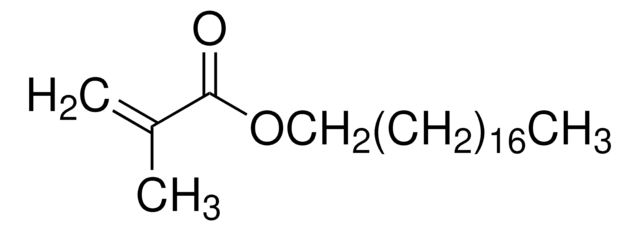291811
Laurylmethacrylat
contains 500 ppm MEHQ as inhibitor, 96%
Synonym(e):
Lauryl-methacrylat
About This Item
Empfohlene Produkte
Assay
96%
Enthält
500 ppm MEHQ as inhibitor
Brechungsindex
n20/D 1.445 (lit.)
bp
142 °C/4 mmHg (lit.)
mp (Schmelzpunkt)
−7 °C (lit.)
Dichte
0.868 g/mL at 25 °C (lit.)
SMILES String
CCCCCCCCCCCCOC(=O)C(C)=C
InChI
1S/C16H30O2/c1-4-5-6-7-8-9-10-11-12-13-14-18-16(17)15(2)3/h2,4-14H2,1,3H3
InChIKey
GMSCBRSQMRDRCD-UHFFFAOYSA-N
Suchen Sie nach ähnlichen Produkten? Aufrufen Leitfaden zum Produktvergleich
Verwandte Kategorien
Allgemeine Beschreibung
Anwendung
- To prepare polymeric co-stabilizer by free-radical copolymerization.
- To fabricate fluorine-less superhydrophobic cotton fabrics via graft polymerization process.
- In the synthesis of prepolymers that are used in oil absorbents.
Signalwort
Warning
H-Sätze
Gefahreneinstufungen
Aquatic Acute 1 - Aquatic Chronic 1 - Eye Irrit. 2 - Skin Irrit. 2 - STOT SE 3
Zielorgane
Respiratory system
Lagerklassenschlüssel
10 - Combustible liquids
WGK
WGK 1
Flammpunkt (°F)
224.6 °F - closed cup
Flammpunkt (°C)
107 °C - closed cup
Persönliche Schutzausrüstung
Eyeshields, Gloves, type ABEK (EN14387) respirator filter
Hier finden Sie alle aktuellen Versionen:
Besitzen Sie dieses Produkt bereits?
In der Dokumentenbibliothek finden Sie die Dokumentation zu den Produkten, die Sie kürzlich erworben haben.
Kunden haben sich ebenfalls angesehen
Unser Team von Wissenschaftlern verfügt über Erfahrung in allen Forschungsbereichen einschließlich Life Science, Materialwissenschaften, chemischer Synthese, Chromatographie, Analytik und vielen mehr..
Setzen Sie sich mit dem technischen Dienst in Verbindung.











